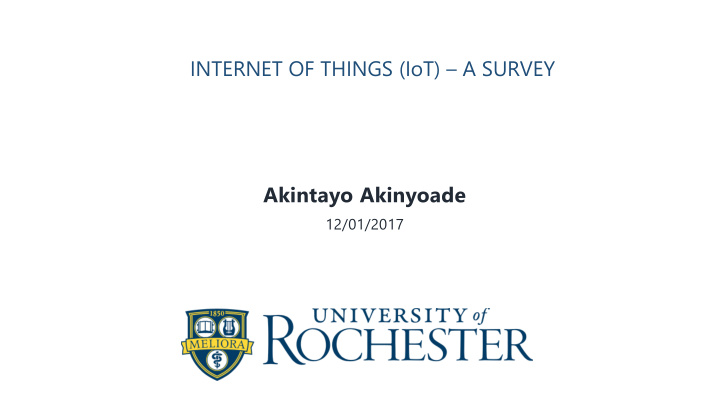



INTERNET OF THINGS (IoT) – A SURVEY Akintayo Akinyoade 12/01/2017
Survey Roadmap Internet of Things (IoT)? Tech. Enablers for IoT IoT Applications Open Research Issues
Internet of Things (IoT) Network Oriented Vision Things Oriented Vision IoT-one paradigm, many vision Semantic Oriented Vision Ref: Informationsecuritybuzz.com “ From anytime, anyplace connectivity for anyone, we will now have ITU Vision - connectivity to anything ”
Internet of Things ( Cont’d ) Originates from the pervasive presence of variety of things or objects – such as RFID tags, sensors ,mobile phones , which through unique addressing are able to interact with each other to reach common goals. Semantically- It’s a world -wide network of interconnected objects that are uniquely addressable based on a standard communication protocol.
IoT Referenced Framework Communication Protocols CoAP – Constrained Application Protocol LWM2M- Lightweight Machine 2 Machine UPnP – Universal Plug and Play MQTT – Message Queue Telemetry Transport HTTP/REST – Representational State Transfer TCP/IP Layers IoT Layers Websockets Source: Chapter 2 The Internet in IoT — OSI, TCP/IP, IPv4, IPv6 and Internet Routing
Technology Enablers for IoT Identification & Sensing • A) Radio Frequency Identification Systems (RFID) - Frequency band LF (124-135KHz) to UHF (860-960MHz) - Monitors object in real-time without them being in line-of-sight - System comprises of Reader & Tags - RFID Tags = Microchip + Antenna (Used for transmitting tag ID and receiving the reader signal) Passive tags - Harvest energy from query signal generated by nearby reader System is characterized with low gain. Use Readers with highly directive antennas to improve gain. Active tags - Contains onboard power supply (i.e. batteries). Wider radio coverage but expensive RFID systems, when augmented with sensor network could help bridge the physical & digital world IEEE 802.15.4 standard defines the physical and MAC layer for low power WPAN
Comparison between RFID systems, wireless sensor networks & RFID sensor networks B) Middleware & Communication - Follows Service Oriented Architecture (SOA) - Abstracts device functionalities and communication capabilities to provide a common set of services and environment for service composition
IoT Applications
Open Research Issues 1. Standards needs to be integrated into a comprehensive framework
2. Addressing and Networking Issues - Limited IPV4 address (32 bits) - IPV6 address to be adopted (128 bits)- large enough to identify any object worth identifying - Concatenate RFID tag identifier with network prefix segment of IPV6 IPV6 address = Gateway ID (64 bits) + Interface ID (64 bits) (Network prefix part) (RFID tag identifier) Pros : Effective for 64 bits Tags Cons: ineffective for 96 long bits Agents = Network element capable of mapping RFID identifier regardless of lengths into 64 bits field - Encapsulating RFID message and header into IPV6 packet payload
2. Addressing and Networking Issues (cont’d) - Need for Object Name Service (ONS) like Domain Name Service (DNS) ONS should be capable of resolving described objects to associated RFID tag identifier and vice versa - New reliable transport layer protocol other than TCP is needed: - Three way handshake wastes limited communication and energy resources - TCP congestion control is useless since amount of data exchanged in a session is small - Buffer management is costly considering the resulting energy consumption. - Little knowledge about Quality of Service (QoS) -Traffic transversed is unknown since deployment is new - Requires traffic characterization and modelling
3. Security and Privacy IoT deployment provides security risk because: - Components spend most times unattended to. Hence, easy to modify data stored at the nodes - Communication is wireless, making eavesdropping extremely simple - Cannot support complex security scheme such as authentication and data integrity due to low energy and computing resources - Proxy attack or man-in-the-middle attack (see figure below)
Research issues at a glance
References 1. The Internet of Things: A Survey, Luigi Atzori, Antonio Iera, Giacomo Morabito, 2010 2. M. Presser, A. Gluhak, The Internet of Things: Connecting the Real World with the Digital World, EURESCOM mess@ge – The Magazine for Telecom Insiders, vol. 2, 2009, <http://www.eurescom.eu/> 3. https://www.informationsecuritybuzz.com 4. https://www.accesseventsolutions.com/rfid-systems
THANK YOU!!!
Recommend
More recommend